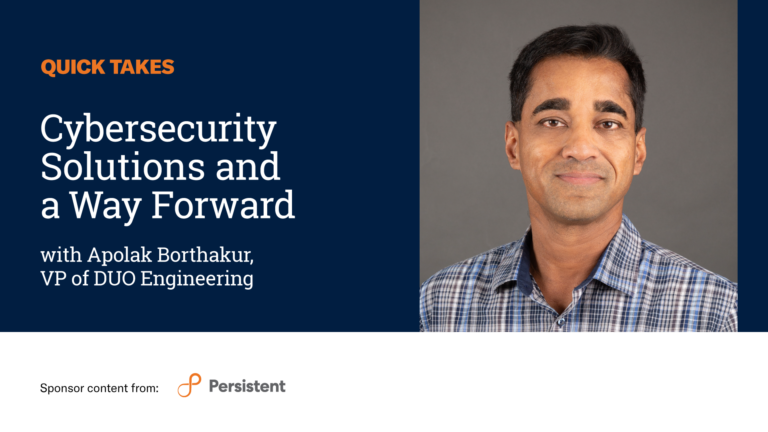Todd Pruzan, HBR: Welcome to HBR Video Quick Take. I’m Todd Pruzan. I am Senior Editor for Research and Special Projects. harvard business review.
We spoke to Apolak Borthakur, vice president of Duo Engineering at Cisco, for insight into organizations’ challenges in balancing cybersecurity and user experience, and where AI fits into that evolution. Mr. Apolak, thank you very much for joining us.
Mr. Apolak Voltakur, Cisco: thank you. It’s great to be here.
Todd Pruzan, HBR: Mr. Apolak, what is your experience in developing and implementing cybersecurity strategies and solutions at Cisco?
Mr. Apolak Voltakur, Cisco: I lead the Cisco Duo product line at Cisco. Duo is a leading identity security vendor and is very widely deployed. I think we have over 30 million licensed users and process almost 2 billion authentications every month. And as part of the leadership team within Cisco Security, I participate in planning and strategy. And I’m very involved in mergers and acquisitions.
Todd Pruzan, HBR:Okay, thank you. Appreciate the context. What are the key emerging trends and technologies in cybersecurity?
Mr. Apolak Voltakur, Cisco: I will mention two of them. One is the transition from point products to integrated platform solutions. This eliminates the need for customers to duplicate tasks between different products, making life much easier. The platform also allows you to see end-to-end correlations. And that is not something you can get by having individual point products.
Another trend we’re seeing is a shift towards identity, the new perimeter of security. And as workloads move to public clouds and SaaS, much of the infrastructure that hackers were leveraging is now below the waterline as far as hackers are concerned. So they’re doubling down on identity violation intrusions. And finally, AI, especially Gen AI, is still in its infancy, but there are a lot of interesting possibilities.
Todd Pruzan, HBR: got it. We see three very strong trends. Apolak, how does Cisco balance the need for strong security with user experience when designing and implementing security solutions?
Mr. Apolak Voltakur, Cisco: Well, being a security product, it is absolutely essential that our products are completely secure in order to continue to earn the trust of our customers. And we need to help our customers meet their security effectiveness goals.
But now more than ever, we’re hearing from our customers that they want a simplified user experience, and we take that very seriously. If you look at Duo, for example, we’ve invested a lot in design. And design is now a fundamental part of our development process.
Duo is also on a mission to democratize security and make it affordable for small and medium-sized businesses. And if you look at our business, a significant portion of it comes from customers who don’t need to speak to a Cisco Duo employee. This is possible because we are passionate about democratizing security and providing a super-simplified experience for our customers.
Todd Pruzan, HBR:And I think our customers will be able to feel the difference as well. How does Cisco manage the evolving digital threat landscape? What do we expect from service providers, such as persistent systems, to help manage these threats?
Mr. Apolak Voltakur, Cisco: Cisco Security has many advanced features across multiple areas. But the real value we’re bringing now is the ability to bring everything together in one unified platform to give our customers end-to-end visibility and correlation that no other company can offer.
This is very important. This is because common breach scenarios such as phishing attempts require solutions that span email, threat detection, endpoints, and network identity. We have it all, and we’ve put it all together to really get you the results you want as a customer.
When it comes to Persistent, we use it in every aspect of engineering. And that includes development. This includes not only quality but also project management.
Todd Pruzan, HBR:Okay, thank you. Mr. Apolak, what do you think about the future of applying AI to cybersecurity?
Mr. Apolak Voltakur, Cisco: First of all, there is a lot of potential in existing machine learning and analytics, which are already being used to detect suspicious or anomalous behavior and potential root causes. But especially Gen AI.
Generative AI – it’s an interesting new field. As you know, we released Assistant and Copilot, and we’re just beginning to scratch the surface. There are still many possibilities for us.
At a very high level, Generative AI allows customers to specify queries in natural language. And behind the scenes, you can collect data from multiple sources, analyze it, and generate responses that make your customers’ jobs easier. There are many interesting possibilities.
Todd Pruzan, HBR: That seems very possible. Mr. Apolak, thank you so much for joining us today and sharing all of your insights on the current and future state of cybersecurity and its ongoing evolution.
Mr. Apolak Voltakur, Cisco:Thank you so much for having me.
Todd Pruzan, HBR: We spoke to Apolak Borthakur, vice president of Duo Engineering at Cisco, about cybersecurity. Click the link below for more information.
See key findings on enterprise IT security at Persistent.com. Here, customer-centric enterprise IT security solutions are designed to enhance and transform every aspect of an organization’s security infrastructure.
Click here for details Persistent enterprise IT security.



